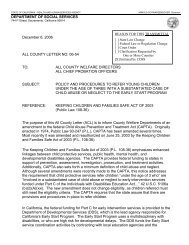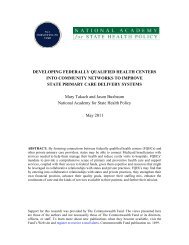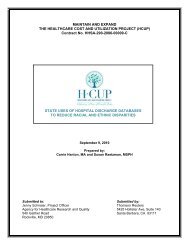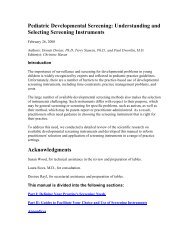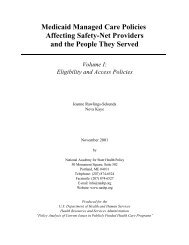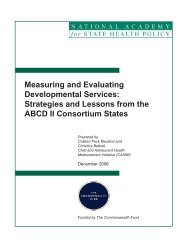Improving Care Coordination, Case Management, and Linkages to
Improving Care Coordination, Case Management, and Linkages to
Improving Care Coordination, Case Management, and Linkages to
You also want an ePaper? Increase the reach of your titles
YUMPU automatically turns print PDFs into web optimized ePapers that Google loves.
28<br />
Mental Retardation), the state’s Department of Education Preschool Special Education Program, <strong>and</strong> pediatric<br />
primary care providers. The Commonwealth Fund supports replicating Help Me Grow in additional states <strong>and</strong> has<br />
a guidebook for states. 84<br />
Datasets <strong>and</strong> registries<br />
In New Hampshire, one large pediatric practice maintains a database of all children in the practice with complex/<br />
special needs (i.e., likely <strong>to</strong> last more than a year). This registry approach allows the practice <strong>to</strong>:<br />
•<br />
•<br />
•<br />
•<br />
•<br />
identify the most complex patients <strong>and</strong> distribute them equally across providers;<br />
identify the families that most need a care plan for their children;<br />
invite families <strong>to</strong> attend focus groups for parents of children with special needs;<br />
appropriately schedule patients who require extra time for appointments; <strong>and</strong><br />
gather information that can be used <strong>to</strong> negotiate with payers for optimal coverage of complex patients.<br />
Over the past decade, Rhode Isl<strong>and</strong> has refined a child health information system, KIDSNET, which is designed<br />
<strong>to</strong> support families <strong>and</strong> providers with health <strong>and</strong> related services. While other states have linked child health<br />
data, few states use this data <strong>to</strong> promote service linkages. KIDSNET links health data from pediatric providers<br />
<strong>and</strong> 10 public health programs including newborn screening, immunization services, Part C Early Intervention, the<br />
Supplemental Nutrition Program for Women, Infants, <strong>and</strong> Children (WIC), home visiting <strong>and</strong> birth defect surveillance.<br />
It provides access <strong>to</strong> linked health information <strong>to</strong> families, doc<strong>to</strong>rs, school nurses, health plans <strong>and</strong> early<br />
care <strong>and</strong> education providers. To facilitate care coordination, Rhode Isl<strong>and</strong> law permits qualified health care professionals<br />
<strong>to</strong> share health data without patient consent. 86 With reliable, real-time data, providers <strong>and</strong> families can<br />
help ensure timely provision of preventive care <strong>and</strong> follow-up services. The universal approach <strong>and</strong> engagement<br />
of a wide array of stakeholders, as well as privacy protections, have sustained this effort since 1997.<br />
Electronic Health Records<br />
An ideal child health system would routinely use electronic health records (EHR), personal health records (PHR)<br />
<strong>and</strong> integrated child health databases based on st<strong>and</strong>ards. 87 New consensus st<strong>and</strong>ards have been developed for<br />
pediatric EHR, through the efforts of the Alliance for Pediatric Quality. 88<br />
Public agency support is essential <strong>to</strong> the success of child health information technology. Public agencies, particularly<br />
public health <strong>and</strong> Medicaid, play an important role developing data st<strong>and</strong>ards, pediatric functions in health<br />
information systems, privacy policies, research <strong>and</strong> implementation funding <strong>and</strong> incentives for technology adoption.<br />
89 Opportunities exist for states <strong>to</strong> move beyond surveillance systems <strong>and</strong> integrated databases in<strong>to</strong> more<br />
effective use of information <strong>to</strong> inform families <strong>and</strong> providers <strong>and</strong> improve linkages in the child health system. 90<br />
Medicaid can be used <strong>to</strong> support exp<strong>and</strong>ed use of health information technology, particularly through administrative<br />
financing for upgraded information systems. Medicaid can also support effective information exchanges<br />
between providers <strong>and</strong> patients, the alignment of incentives for quality based on information <strong>and</strong> the application<br />
of new technology <strong>and</strong> st<strong>and</strong>ards. The Center for Medicare <strong>and</strong> Medicaid Services-sponsored Medicaid Information<br />
Technology Architecture Initiative, which is aligned with the goals of the Nationwide Health Information<br />
Infrastructure <strong>and</strong> the Strategic Framework, would enable a physician’s EHR system <strong>to</strong> connect <strong>to</strong> the Medicaid<br />
agency <strong>to</strong> validate eligibility, review utilization data, authorize payments <strong>and</strong> complete other tasks. 91<br />
Referral Forms <strong>and</strong> Processes<br />
Many state <strong>and</strong> local child health leaders have noted that most pediatric primary care practices only have referral<br />
forms designed <strong>to</strong> link patients <strong>to</strong> other physicians. Forms are needed that facilitate referrals <strong>to</strong> a wider array of<br />
<strong>Improving</strong> <strong>Care</strong> <strong>Coordination</strong>, <strong>Case</strong> <strong>Management</strong>, <strong>and</strong> <strong>Linkages</strong> <strong>to</strong> Service for Young Children: Opportunities for States<br />
National Academy for State Health Policy<br />
85



